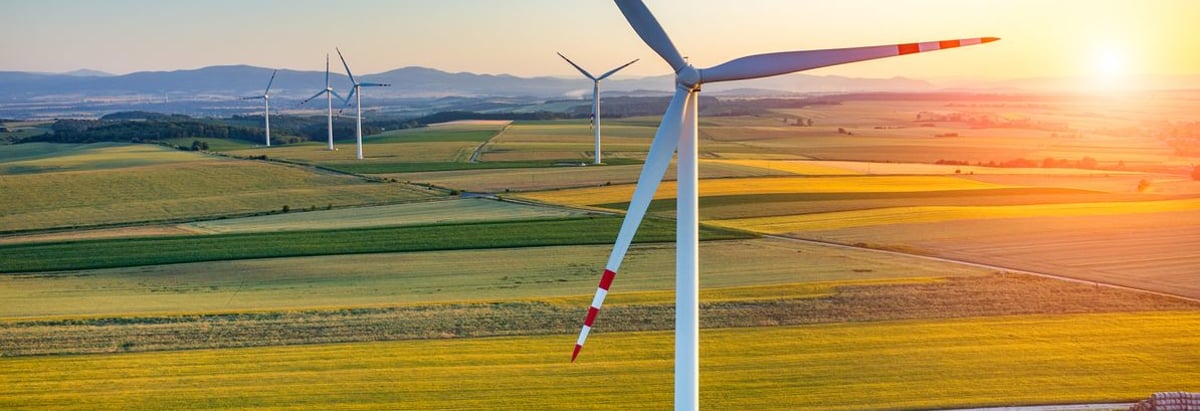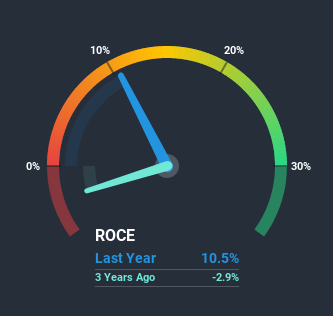
There are a few key trends to look for if we want to identify the next multi-bagger. Firstly, we'd want to identify a growing return on capital employed (ROCE) and then alongside that, an ever-increasing base of capital employed. Ultimately, this demonstrates that it's a business that is reinvesting profits at increasing rates of return. So when we looked at NZ Windfarms (NZSE:NWF) and its trend of ROCE, we really liked what we saw.
What is Return On Capital Employed (ROCE)?
For those that aren't sure what ROCE is, it measures the amount of pre-tax profits a company can generate from the capital employed in its business. Analysts use this formula to calculate it for NZ Windfarms:
Return on Capital Employed = Earnings Before Interest and Tax (EBIT) ÷ (Total Assets - Current Liabilities)
0.10 = NZ$5.3m ÷ (NZ$54m - NZ$3.7m) (Based on the trailing twelve months to June 2020).
Therefore, NZ Windfarms has an ROCE of 10%. In absolute terms, that's a satisfactory return, but compared to the Renewable Energy industry average of 2.5% it's much better.
Check out our latest analysis for NZ Windfarms

Historical performance is a great place to start when researching a stock so above you can see the gauge for NZ Windfarms' ROCE against it's prior returns. If you want to delve into the historical earnings, revenue and cash flow of NZ Windfarms, check out these free graphs here.
What Can We Tell From NZ Windfarms' ROCE Trend?
You'd find it hard not to be impressed with the ROCE trend at NZ Windfarms. The data shows that returns on capital have increased by 2,480% over the trailing five years. That's a very favorable trend because this means that the company is earning more per dollar of capital that's being employed. Speaking of capital employed, the company is actually utilizing 32% less than it was five years ago, which can be indicative of a business that's improving its efficiency. If this trend continues, the business might be getting more efficient but it's shrinking in terms of total assets.
What We Can Learn From NZ Windfarms' ROCE
In the end, NZ Windfarms has proven it's capital allocation skills are good with those higher returns from less amount of capital. Since the stock has returned a staggering 249% to shareholders over the last five years, it looks like investors are recognizing these changes. Therefore, we think it would be worth your time to check if these trends are going to continue.
If you want to continue researching NZ Windfarms, you might be interested to know about the 3 warning signs that our analysis has discovered.
While NZ Windfarms may not currently earn the highest returns, we've compiled a list of companies that currently earn more than 25% return on equity. Check out this free list here.
If you decide to trade NZ Windfarms, use the lowest-cost* platform that is rated #1 Overall by Barron’s, Interactive Brokers. Trade stocks, options, futures, forex, bonds and funds on 135 markets, all from a single integrated account. Promoted
Valuation is complex, but we're here to simplify it.
Discover if NZ Windfarms might be undervalued or overvalued with our detailed analysis, featuring fair value estimates, potential risks, dividends, insider trades, and its financial condition.
Access Free AnalysisThis article by Simply Wall St is general in nature. It does not constitute a recommendation to buy or sell any stock, and does not take account of your objectives, or your financial situation. We aim to bring you long-term focused analysis driven by fundamental data. Note that our analysis may not factor in the latest price-sensitive company announcements or qualitative material. Simply Wall St has no position in any stocks mentioned.
*Interactive Brokers Rated Lowest Cost Broker by StockBrokers.com Annual Online Review 2020
Have feedback on this article? Concerned about the content? Get in touch with us directly. Alternatively, email editorial-team (at) simplywallst.com.
About NZSE:NWF
NZ Windfarms
Generates and sells renewable electricity to the national grid in New Zealand.
Flawless balance sheet low.
Market Insights
Community Narratives



